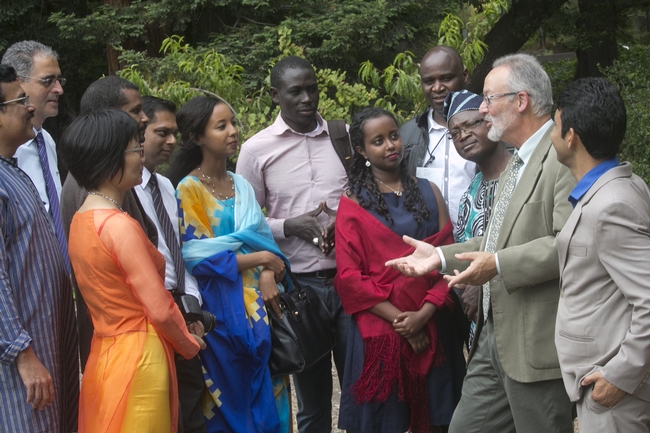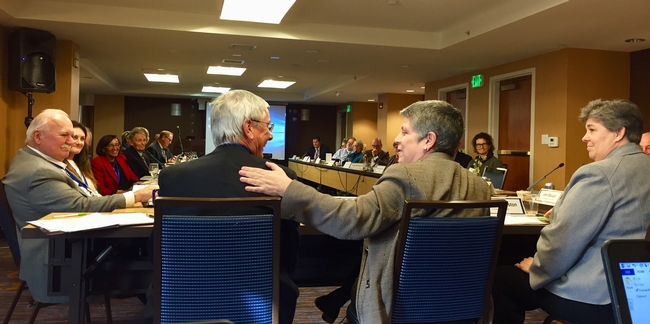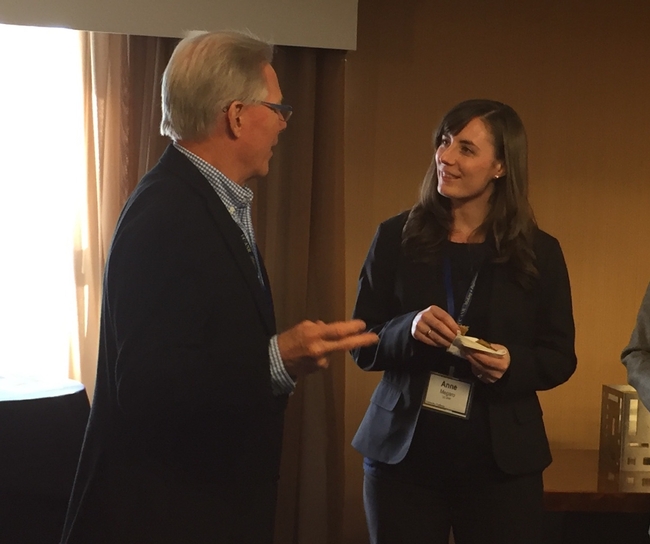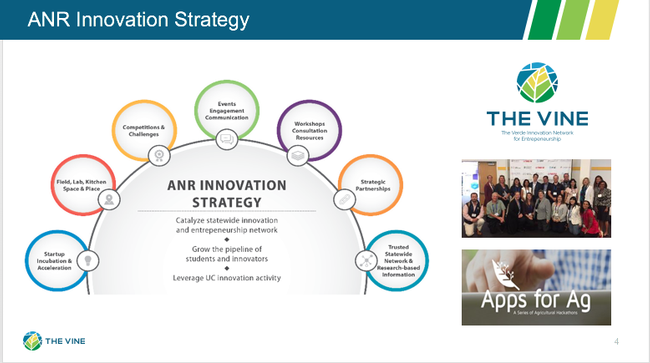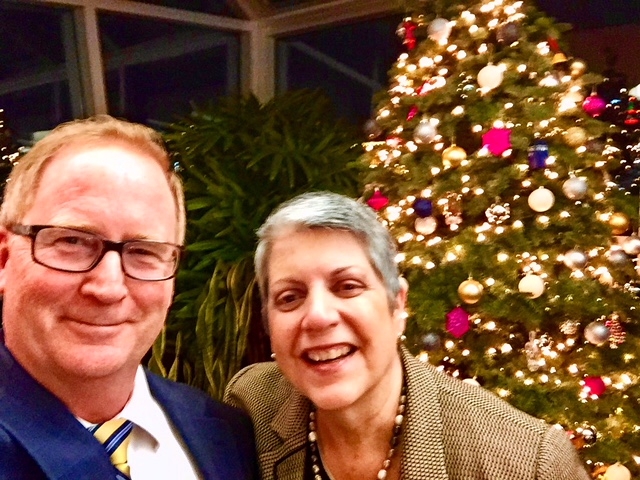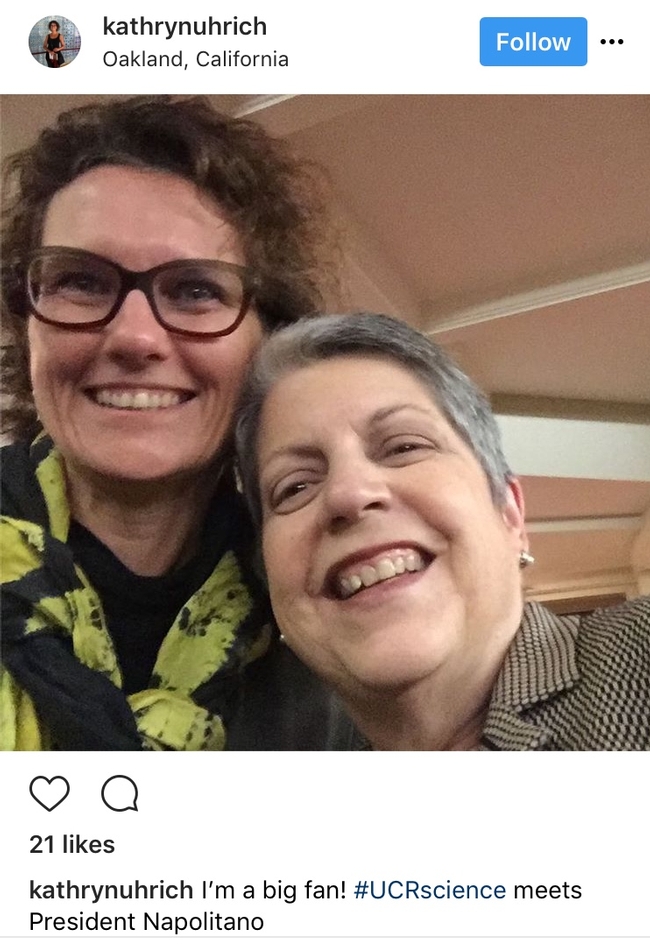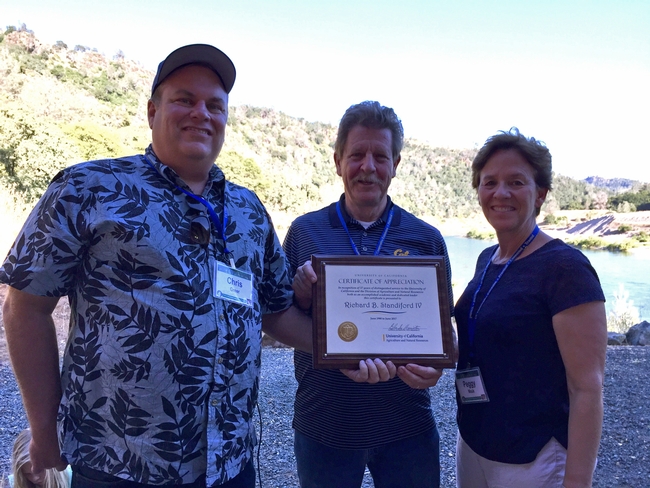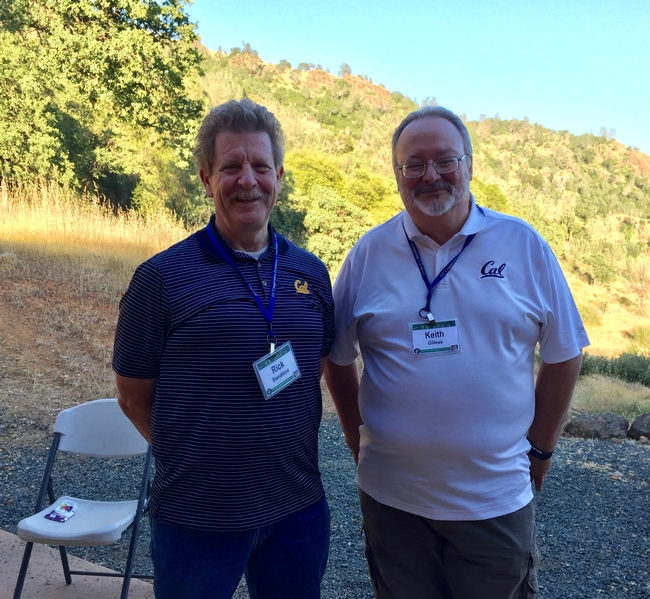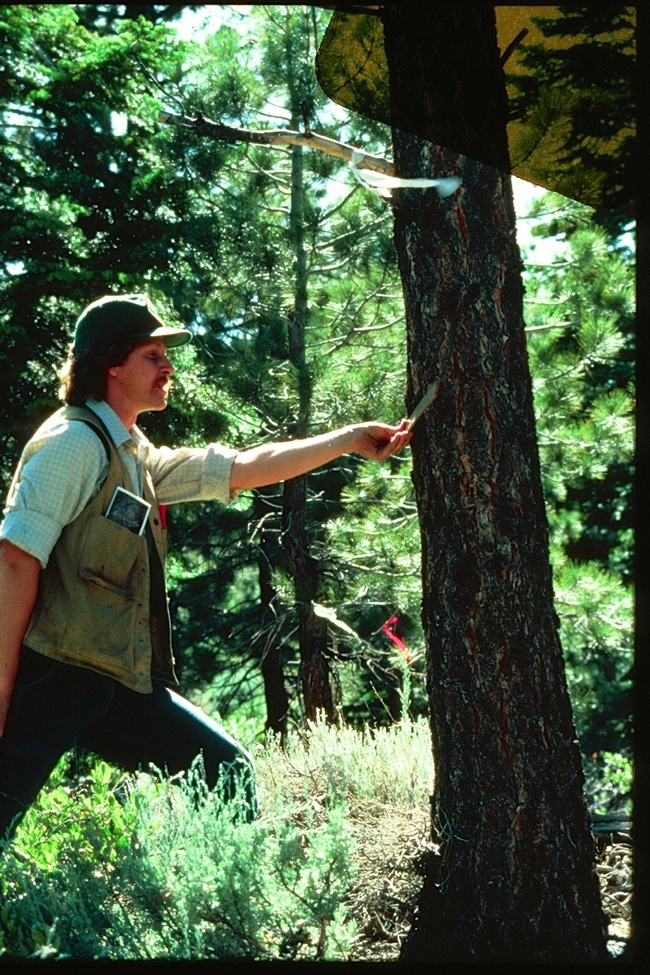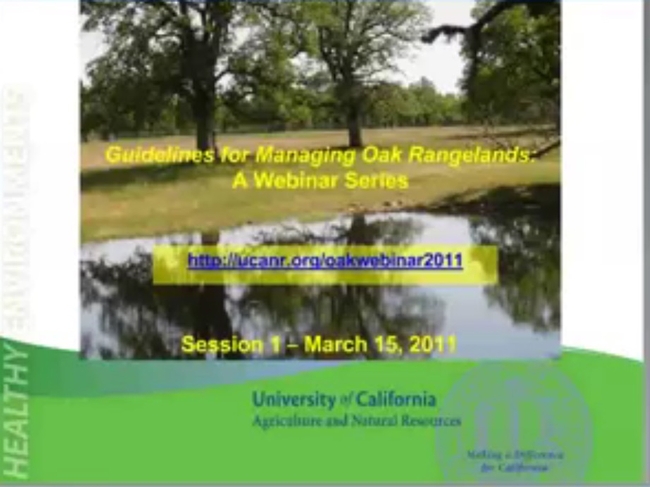Posts Tagged: Keith Gilless
Q&A: Gilless reflects on CNR
After 11 years leading the College of Natural Resources at UC Berkeley, Dean J. Keith Gilless stepped down from his post in June. As dean, Gilless has been dedicated to supporting CNR's diverse research, teaching and outreach activities. He has led the college through major growth, launched a number of interdisciplinary initiatives and tackled infrastructure-renewal projects. After completing his second term, Gilless—who has been a professor of forest economics at Berkeley since 1983—will continue to teach, conduct research and serve as the chair of the California Board of Forestry and Fire Protection.
Looking back on the past 11 years, what are your proudest moments?
The entire CNR community has a lot to feel proud about. We've doubled the number of undergraduates in the College by responding to students' intellectual and career interests and creating a strong culture of advising and student support. Despite budget constraints, we found ways to create two new cross-campus centers: the Berkeley Food Institute and the Institute for Parks, People, and Biodiversity. We launched the Master of Development Practice program. We became more successful and sophisticated in our fundraising efforts, allowing us to increase graduate student support and make some much-needed improvements to our infrastructure. We expanded our network of research forests at a pivotal time for understanding the effects of climate change on California's ecosystems. And we've been a major contributor to campus-wide initiatives in biofuels and gene editing.
Beyond this long list, what makes me proudest is that UC Berkeley has come to recognize CNR as one of its most successful and dynamic centers of excellence. Our college embodies the relevance in modern society of the vision that created the land-grant universities. We share the mission of Berkeley —and of public education generally—to serve society through problem-solving research and discovery, instruction that enables students to realize their potential, and public service. Here, we really do aspire to “See the bigger picture and make a better world.”
Favorite memory of being dean?
That's easy: congratulating students at commencement. Education transforms lives. My own education—and my participation in the research and educational mission of UC Berkeley—transformed my life and my understanding of society and the environment around me. Berkeley students are overwhelmingly the first or second generation in their family to attend college. When they cross the stage in cap and gown, and their families and other loved ones applaud and cry, I feel privileged to have been allowed to be a part of their joy on that day.
What are the needs and opportunities you see for the College going forward?
Continued success for CNR depends on our ability to continue to grow our philanthropic base. Success here will help us to improve our facilities, fund cutting-edge research, and achieve strong financial support for our graduate students. We must also ensure that all members of our community feel they are heard, valued, and respected. I firmly believe that we can meet these challenges, in part because what we do is so directly relevant to many of the difficult problems facing our world—these are problems people want to solve. Complex issues require interdisciplinary solutions, and that's something at which this College excels.
CNR doesn't exist in a vacuum. Our fate is inextricably tied to the fate of the campus, and the fate of public education. No single unit can succeed without collaborating across administrative boundaries—and without the campus successfully addressing its financial challenges with respect to aging infrastructure, accessibility, and housing, among other issues. CNR needs to help Berkeley thrive in order to thrive itself.
Any other thoughts?
I've been part of the Berkeley and CNR community for 35 years and have enjoyed it all. I never cease to be amazed at the opportunities to interact with brilliant and inquisitive students; faculty colleagues who set the bar for excellence in research, teaching, and service; and dedicated staff who keep the College running no matter how difficult things get. I have never known what to expect at each new stage in my career here, other than that I would find myself working with people who inspire me to try harder to do a good job. As I change my business card back to reading simply “Professor of Forest Economics,” I know this feeling will continue.
PAC discusses innovation and advocacy
Kicking off the meeting by expressing sympathy for everyone affected by wildfires – including the ANR members and Master Gardener volunteers who lost their homes – UC President Janet Napolitano met with the President's Advisory Commission (PAC) at their biannual meeting Dec. 13 at the Courtyard by Marriott in Emeryville.
President Napolitano focused her remarks on the challenges that remain with our food system, saying that she sees endless possibilities for ANR to bring food and ag together with science and technology for agricultural innovation. She also praised ANR for expanding access to its programs and achieving parity in participation of Latino youth in 4-H activities.
Asked about UC's role in production of the state's newly legal crop, Napolitano asked for a report from a systemwide group studying how UC can get involved in cannabis research without running afoul of federal law. VP Chief of Staff Jan Corlett, who represents ANR in that group, offered to relay the PAC's comments at their next meeting.
Napolitano invited the PAC members to join the UC Advocacy Network, or UCAN, to keep informed about state and federal issues that impact the university.
VP Glenda Humiston introduced Anne Megaro, governmental and community relations director. Megaro, who has a Ph.D. in animal science and was the California State Senate Committee on Agriculture's consultant for five years, spoke about her background and discussed how she is working with academics to cultivate relationships with elected officials by sharing stories about their work.
“Every legislator should know ANR because we're in their district,” Megaro said.
“How can I help you talk about ANR?” she asked the PAC members, who responded positively.
Gabe Youtsey, chief innovation officer, described how the Internet of Things, data analysis, robotics, artificial intelligence, drones and plant biotechnology are helping farmers cope with challenges, including workforce shortages, water scarcity and pest pressure. The Apps for Ag hackathons have produced useful tools, but poor rural connectivity is limiting the benefits.
“If we don't solve rural connectivity,” Youtsey warned, “We'll have ag brick instead of ag tech because it won't work.”
He also described the recently launched The VINE, which is designed to catalyze a statewide system to support innovation, entrepreneurship, expand economic opportunities and develop new technology for agriculture, natural resources and rural communities. Youtsey said food and agriculture need “patient capital” investors because venture capitalists desire a fast return on their investment.
Associate Vice President Wendy Powers briefed the commission on ANR's strategic plan. Our “Big Hairy Audacious Goal” is for every Californian to recognize the positive impact ANR has in their lives. The actions will be guided by UCANR's core values: excellence, community, innovation, inclusion, collaboration and integrity. Public value statements are being developed to shape our efforts and “they will give us the elevator speech to articulate who we are and what we do,” Powers said.
Powers also updated the PAC on recent successes, including boosting Giving Tuesday donations by 24 percent over 2016. She announced that 4-H increased its statewide youth enrollment by 18 percent and number of 4-H volunteers by 15 percent and that ANR has completed a salary equity program for staff and advisors and continues to improve internet speeds in county and REC facilities.
In the deans' updates, Keith Gilless announced that in June he will be stepping down as dean of the College of Natural Resources after 11 years to return to his academic work in fire research. Deans Helene Dillard of the College of Agricultural and Environmental Sciences, Kathryn Uhrich of the College of Natural and Agricultural Sciences, Michael Lairmore of the School of Veterinary Medicine and Gilless shared news of awards and large grants received and major projects underway in their respective colleges and school.
In wrapping up the meeting, Humiston announced that Mike Mellano, Dina Moore and Jean Marie Peltier will represent California in Washington D.C. for the CARET (Council on Agriculture Research, Extension and Teaching) meeting in March to advocate for agricultural research and the Farm Bill.
She invited the PAC members to meet next in April in Ontario, in conjunction with the ANR statewide meeting.
Standiford retires from 37-year UC ANR career
Wrapping up a remarkable 37-year career with UC ANR, Richard B. Standiford IV, UC Cooperative Extension forest management specialist at UC Berkeley, will retire June 30.
In addition to being a highly regarded forestry expert, Standiford served as UC ANR's associate vice president from 2005 to 2009, and provided stability for the division as acting vice president during the 11-month transition from Reg Gomes stepping down to retire until Daniel Dooley succeeded him as vice president in 2008.
“There are a select few individuals who both excel at research, teaching, service and outreach and can lead and motivate others to try to do the same. Rick belongs to this rarest subspecies of academic,” said Keith Gilless, dean of the College of Natural Resources at UC Berkeley, who has worked with Standiford for 35 years.
In 1980, after working two years as a research and extension forester at Purdue University, Standiford joined UC Cooperative Extension at UC Berkeley. The New Jersey native developed a research and extension program focused on sound management of California's forests, rangelands and other natural resources.
Standiford “personifies all that is best about Cooperative Extension,” said Maggi Kelly, director of the UC ANR Statewide Informatics and Geographic Information Systems Program, professor and Cooperative Extension specialist in the Department of Environmental Sciences, Policy & Management at UC Berkeley.
His legacy in Cooperative Extension continued to grow as associate vice president of ANR, says Peggy Mauk, former director for Central Coast and South Region.
“Rick empowered people, empowered regional directors and county directors to implement programs for the betterment of California,” Mauk said. “Rick had the ability to bridge the gap between administrative concepts and regional (county) implementation. He wanted to know how higher level decisions would impact ANR's county-based personnel and programs and then adjust for those impacts. Above all, Rick valued people and positions, and supported the ANR mission.”
He also has provided leadership for county Cooperative Extension advisors developing programs in forestry and conservation of oak woodlands.
“Rick has a tremendous ability to pull people together,” said Yana Valachovic, UCCE director and forest advisor for Humboldt and Del Norte counties, noting his leadership in getting people to work together to contain sudden oak death disease. “It takes passion, vision and an ability to communicate effectively.”
While tackling the emerging forest disease, Standiford also devoted time to mentoring young scientists.
“Early in 2000, Rick bounced into my office with the news that he had found emergency funds to study the disease, and had assembled a team of pathologists, ecologists, arborists, homeowners and forest managers to attack the problem,” said Kelly, a remote-sensing expert. “Rick asked if I would be able to use the money to fly to Marin County and develop critical baseline maps of the nascent disease. I was, and I did, and that generosity and foresight launched my applied research and extension program at Berkeley.”
“The disease was subsequently named Sudden Oak Death, and in 2015 ANR was been given a nationwide award in extension for its timely, quality, impactful multidisciplinary approach to the disease,” Kelly said, “and it all started with Rick.”
Standiford said working with people was the part of his career he enjoyed most. He recalled driving with UCCE colleagues to Mariposa County to deliver a workshop on managing oaks.
“The sun was setting, it's pretty dark, pretty desolate and we're wondering, ‘Is anybody going to be at the workshop?'” Standiford said. “At the grange hall in Catheys Valley, there's a ton of pickup trucks and cars. Inside, everybody is excited that the university has shown up to help figure out how to manage their trees. That's what my job has been about. It was always a lot of fun.”
An early adopter of technology, Standiford has used webinars to teach oak woodland management from a distance. While acknowledging the convenience of virtual meetings, he said, “I hope we don't lose sight of the value of personal contact.”
From 1985 to 1987, Standiford served as ANR program director for natural resources, leading efforts in forestry, wood products, wildlife and range management.
From 1988 to 1999, Standiford led collaboration among UC, the California Department of Forestry and Fire Protection, and the California Department of Fish and Game for the ANR statewide Integrated Hardwood Range Management Program, which was established in 1986 by the California Legislature to address poor oak regeneration and ongoing woodland losses. The program continued for 23 years until its budget was cut in 2009.
At UC Berkeley, he coordinated all Cooperative Extension activities in the Department of Forestry and Resource Management from 1989 to 1993, served as associate dean for forestry and director of the Center for Forestry from 1998 to 2002 in the College of Natural Resources, and oversaw the College's capital projects program, space planning and research infrastructure as associate dean for forestry and capital projects from 2002 to 2004.
In retirement, Standiford plans to teach at the UC forestry camp and remain active with the Society of American Foresters. He also plans to travel with his wife, Judy, and spend time coaching and camping with his five grandchildren
“I have been blessed with the most wonderful job in the world,” Standiford said. “The best part was the honor of working with such wonderful people on campus, in the counties, and the wide group of landowners and managers who taught me so much.”
AVP Powers announces 51 proposals invited for competitive and high-reward grants
AVP Wendy Powers announced the letters of intent (LOIs) for which principal investigators have been invited to submit full proposals to ANR's Competitive Grants Program and High-Risk/High-Reward Grants Program. The list of 51 approved projects can be found at http://ucanr.edu/sites/anrstaff/files/261626.pdf.
This year ANR received a total of 108 letters of intent — 97 for the Competitive Grants Program and 11 for the High-Risk/High-Reward Grants Program. Strategic Initiative leaders and their respective panels reviewed all letters of intent thoroughly to address the appropriateness of the proposals in addressing the goals and criteria outlined by each funding opportunity.
ANR Competitive Grants Program
The purpose of the ANR competitive grants program is to address high-priority issue areas identified by at least one of the strategic initiatives: Endemic and Invasive Pests and Diseases (EIPD), Healthy Families and Communities (HFC), Sustainable Food Systems (SFS), Sustainable Natural Ecosystems (SNE), and Water Quality, Quantity and Security (Water).
ANR Competitive Grants Program 2017 Cycle:
- Full proposals due June 19
- Technical peer review: mid-June – early September 2017
- Strategic Initiative review and recommendations: end of September 2017
- Program Council review and recommendations: October/November 2017
- Announcement of funded grants: November/December 2017
High-Risk/High-Reward Grants Program
Given the complexity of societal problems, high-risk research is necessary to achieve gains for real progress in addressing present and emerging challenges. This program will provide funds to initiate and complete research and proof-of-concept efforts that serve as the basis for larger funding opportunities. These projects must be of a high-risk/high-reward nature that are best conducted in a controlled, research setting and, if successful, lend themselves to subsequent larger funding opportunities and/or intellectual property development.
Proposed projects must be within the scope of the ANR Strategic Vision. All ANR academics with PI status are eligible to apply. Proposals will be accepted using the same timeline as outlined for the traditional competitive grants program, but reviewed separately due to the nature of the proposal.
For questions about ANR's competitive grants program or high-risk/high-reward grants program, please contact Melanie Caruso at mmcaruso@ucanr.edu.
Nutrition Policy Institute launches Research to Action news brief
The Nutrition Policy Institute has launched a news brief called Research to Action. The publication will provide information on research, policy, news, announcements, events, articles and action items focused on nutrition and healthy communities.
The first issue looks at the work of the National Drinking Water Alliance (NDWA). NPI is the “hub” for NDWA, which engages in and coordinates evidence-based efforts going on all over the country to improve tap water safety and access, especially for children, and to provide drinking water education and promotion. The NDWA website is a “go-to” resource for information on drinking water.
Future editions of Research to Action will be sent several times per year. Please sign up for the Research to Action mailing list, and please share Research to Action with colleagues who would be interested in receiving it.

